
UBUNTU in the Xhosa culture means: “I am because we are”.

UBUNTU in the Xhosa culture means: “I am because we are”.

Welcome to my maiden voyage into cyberspace, and launching pad for The Beverly Johnson Lifestyle Brand. “ALL THINGS BEVERLY” and “ALL THINGS BEAUTIFUL” will be shared with you on this website.
My vision, ever since my historic Vogue magazine cover, has been based on a few simple premises: Elegance, Beauty, Sophistication, and Love. Being the first African-American woman on the cover of Vogue Magazine allowed me the opportunity to represent people of color in a different light and allowed me the great opportunity to fully embrace all the beauty of the multicultural woman.
As a result of my many years in the high fashion and beauty industries, I have become the multicultural expert and leader for products that cut across race and nationalities. I have a wealth of experience and gravitas in the hair, beauty, cosmetics and fashion industries and I have come to be known as a global expert. My products are world class, designed for and applicable to all women of color.
I had the opportunity for the last 14 years of being the face and name of Amekor Industries, one of the leading wig and hair extension companies in the United States. I decided it was time for me to create by own destiny and not extend my contract with Amekor Industries. So, I made the ultimate leap of faith and decided to create, manufacture, and distribute my own line of products instead of endorsing someone else’s. I am realizing my dream of being a true “Modelpreneur,” a supermodel and an entrepreneur by owning and manufacturing the products I love under my new company, BJE LLC.
Therefore, I am proud to follow in the tradition of Madame C.J. Walker, one of the first African-American pioneers who, with “two dollars and a dream,” built a multi-million dollar beauty empire in 1917 by formulating her own hair care products. I am invoking that same pioneering spirit with The Beverly Johnson Lifestyle Brand, which will include hair care, skin care, bath & body, color, and more in the spring of 2012.
Starting with the premise that a woman’s glory is her hair, I would like to introduce you to my new luxurious hair care line with Supermodel Formulas: A hair care line with Model Logic. The products in the Model Logic line are based on formulas I have used for years. And now with the help of my professional team, I am able to offer luxurious, salon quality products for you to use at home.
My bath and body products, “Beautiful Body by Beverly”, are great as well. I suggest starting with my Superb Body Wash and Luscious Body Cream. They are to die for!
And “Flawless Skin”, my line of skincare products, are my personal secret to beautiful skin and are designed to help make you look, feel, and be your best. I can’t wait to share them with you!
Think Beauty.
I want to thank you for all your loyalty and support over the years and I look forward to your continued support going forward.
And I say to you, realize your dreams, ‘cause girl if I can do it, you can do it too!’
For the Very Best in Life!
Love,
Beverly
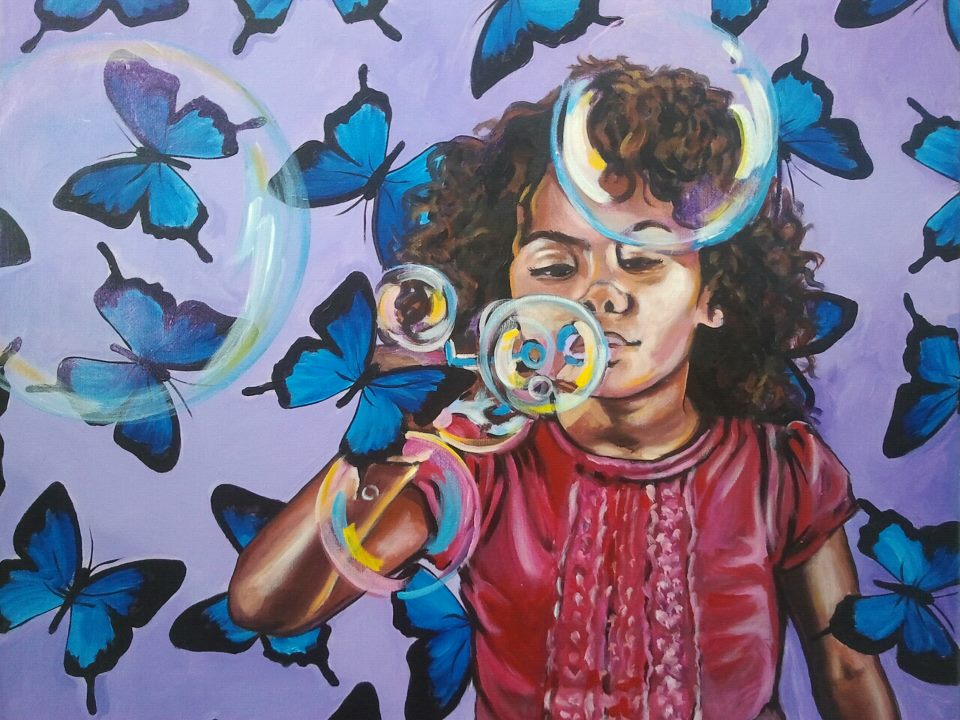
Artist Statement
My artwork reflects the inherent strength within us.
I believe we are in continual transition whether physically, spiritually, mentally or emotionally. We have physical vehicles housing and moving us such as buildings, cars, planes, and our own bodies…but faith, empowerment, events or circumstances seem to shift our lives in more subtle, sublime and urgent forms.My artwork reveals these forms and inspires viewers to develop self-abilities while conceding to our incontestable connection with one another. Rearranged visual syntax, drawn words, symbols, and mixed media are inspirations I allow to deliberately bridge the gap between verbal and visual language. Such demeanor allows visual language the same reward as verbal language: an interaction of tangible and abstract experiences all the while expanding its tenure beyond cultural restriction and translation.
I believe we are a reflection and a result of each other regardless of our differences. Our arts should explore, experience, then express life from our own viewpoints; creating until our experience has become our expression.
“You sense what people call passion” when you are around Clayton Singleton. This Virginia resident’s blend of verbal and visual art inspires, motivates and educates. He received his B.A. in Art from Virginia Wesleyan College then later graduated from Regent University with his Masters of Arts in Education. He is currently working for Norfolk Public Schools where he has taught K-12 visual art and won teacher of the year at the elementary, middle and high school levels as well assisted in rewriting the visual arts curriculum for Norfolk Public Schools. In addition to being a member of the Hampton Roads National Poetry Slam Team, he has painted public murals, produced several solo shows including his latest gallery show at The Selden Gallery, Walking On Paper. The Virginia Opera commissioned Clayton to design sets for Porgy and Bess and Freedom’s Journey. Clayton is also a member of The d’ART Center Board of Directors and Norfolk Arts Commission. He currently teaches visual art and serves as a teacher mentor and department chairperson at Lake Taylor High School in Norfolk. Currently, he uses his children’s book Dream An Awesome Dream and his book of poetic lecture Escape from Freedom during his interactive presentations when he speaks at educational symposiums. Clayton has served as keynote speaker for new teacher orientations and has presented at national conferences including Improving America’s Schools and The Panasonic Foundation’s Leadership Associates Programs. Clayton recently gave a presentation in Portland, Oregon on Powerful Literacy.
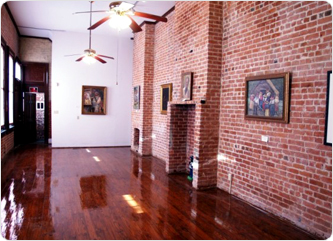
The George & Leah McKenna Museum of African American Art is an institution that collects, interprets and preserves the visual aesthetic of people of African descent in North America and beyond. Through innovative programs and exhibits that engage versatile audiences, the McKenna Museum seeks to make African Diasporan fine art accessible to visitors of all ages. The institution also actively identifies and presents emerging artists alongside well-established fine arts masters.
Featuring the private collection of Dr. Dwight McKenna, the Museum presents works by local
and internationally-renowned artists such as Henry Ossawa Tanner, William Edouard Scott, Clementine Hunter, Ernie Barnes and Ulrich Jean Pierre.
Located in New Orleans, the McKenna Museum is committed to the preservation of the distinct culture found within the African American community of Louisiana.
The McKenna Museum is located in the beautiful Garden District neighborhood of Uptown New Orleans just a block off of St. Charles Avenue. Easily accessible by bus and street car, the McKenna Museum is just a 5 minute drive or scenic ride from downtown.
 As a part of the University’s 175 year anniversary celebration, Cheyney University of Pennsylvania has partnered with the National Black College Alumni Hall of Fame Foundation to host the HBCU Legacy Lecture Series on its campus on Tuesday, April 17, 2012. The program will be held in the Dudley Theatre on the University’s historic quad.
As a part of the University’s 175 year anniversary celebration, Cheyney University of Pennsylvania has partnered with the National Black College Alumni Hall of Fame Foundation to host the HBCU Legacy Lecture Series on its campus on Tuesday, April 17, 2012. The program will be held in the Dudley Theatre on the University’s historic quad.
Special guest panelists include: Actress, Terri J. Vaughn (best known for her role on the Steve Harvey Show), TV Personality, Jeff Johnson (BET), and Founder and Chairman of the National Black College Alumni Hall of Fame, Thomas Dortch, and Cheyney Alumnus & Entrepreneur, Shawn Adderly.
(MUST SEE) A student roundtable discussion entitled “Road to Redemption” at 5 pm will precede the main event. This forum will feature a discussion with student leaders about politics and ethics. Special guest speaker, Kwame Kilpatrick, former mayor of Detroit, will talk to students about his lessons learned while in the political spotlight.
(MAIN EVENT) The main event will feature a panel discussion entitled “Hoodies, Race & Education. Where do you stand?” which begins at 6 PM. The panelists will discuss topics that relate to the Trayvon Martin case, the Commonwealth’s laws pertaining to voting (i.e., photo identification requirement), and the upcoming election. Dr. Weldon McWilliams, a Professor at Cheyney University in the Social & Behavioral Science Department, is the moderator.
In support of local HBCUs, the National Black College Hall of Fame will offer book scholarships valuing $500 each by way of a raffle drawing to two students in attendance.
Just confirmed: Radio One On-Air Personality, E. Steven Collins, will participate as a panelist during the main event!
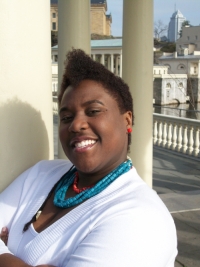
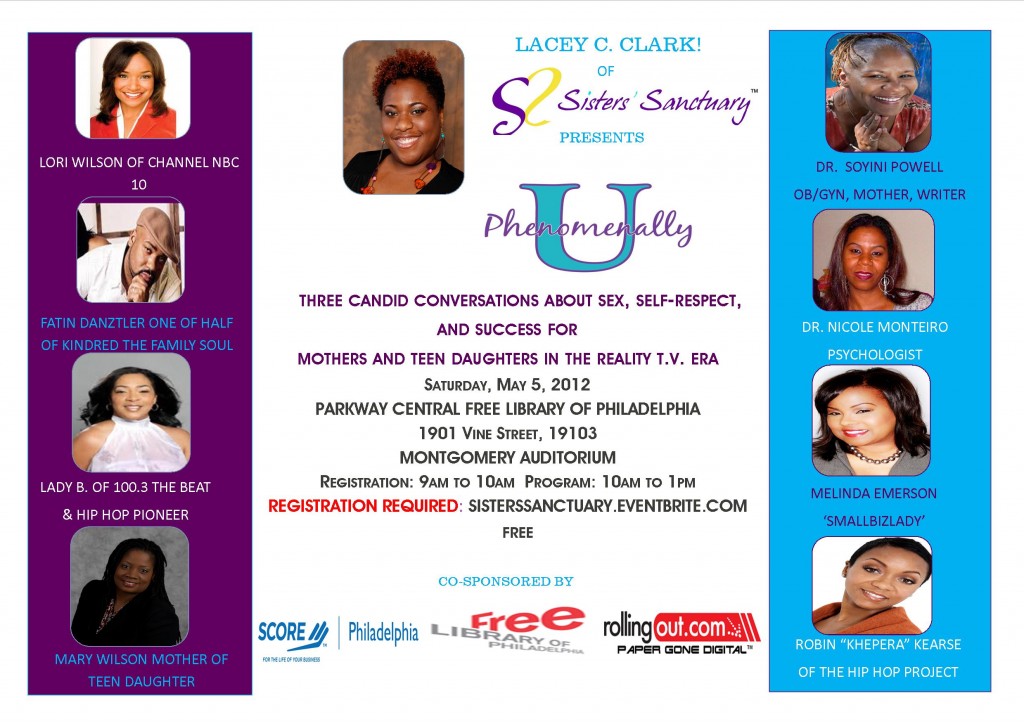
Sisters’ Sanctuary is a movement that celebrates the mental, physical, and emotional well being of womanhood to reclaim ownership of their families and to take holistic responsibility for the rearing and nurturing of our youth.
My name is Lacey C. Clark! and I’d like to share with you the story of how and why I created Sisters’ Sanctuary™.
The inspiration for Sisters’ Santuary™ came to me the first time I heard Jill Scott’s poem, “The Thickness”. Upon hearing that poem I cried. I was that “baby” Scott eloquently speaks about, who sought attention from men by putting on tight jeans, or short skirts. I didn’t feel attractive unless some random man validated my sexiness with a vulgar comment from the window of his car.
Hip-Hop music videos also inspired me. Quite frankly, I’m sick of women being denounced to decoration; sexual objects and trophies for male pleasure. Rarely do we hear songs or see images that praise the depth and grace of women. We’ve been reduced to Baby’s, Mommas, “Boo’s”, “Shawties”, “Hot Chocolates” , “Dimes”, “Chyna Dolls” and straight up Bitches.
Women are radiant and powerful beyond their thongs and stilettos. Sometimes even we forget our depth believing that beauty is cleavage, “phat asses”, diamond studs, weaves, hazel contacts lens, acrylic nail tips, wigs, juicy lipstick, fur coats and trendy clothes.
I began on my journey by fighting my own way out of the cycle. I worked hard, graduated from NYU as a Founder Scholar and went to work in the development department of Spike Lee’s production company, 40 Acres and a Mule. Then I spent some time teaching abroad in Ghana, West Africa at the National Film and Television Institute. Ultimately I realized that what I wanted to do with my life was to support other young women to realize their divine potential. I wanted to create a safe place where we women could encourage each other and restore or develop self-worth and self-love beyond materialism.
I designed SISTERS’ SANCTUARY™ to start the self-work early, helping young women to begin to make sense of their past for a more peaceful fulfilling future.
I believe young women need a space where they can reflect on who they are and how they got to be that way. A space where they can learn important life skills to help them develop a healthy and peaceful lifestyle…. A place to focus on themselves.
SISTERS’ SANCTUARY™ participants learn how to claim their personal power, value responsibility and accountability, value their bodies beyond sexuality, dress for personal respect and success, practice peace, create healthy boundaries, practice self-love, embrace and celebrate excellence, honor and respect their elders and design and execute their goals.
I believe SISTERS’ SANCTUARY™ is necessary because MTV and BET are parenting our children. Music Videos have replaced cartoons and the “Village to raise a child” African concept has been exchanged for minding our own business.
Self-hatred is a billion dollar industry. Society creates a standardize image of beauty which is usually unrealistic or unattainable. And those images are what these corporations condition us with. Selling young women “hope” in advertising for relaxers, perfume, clothes, jewelry and feminine products.
SISTERS’ SANCTUARY™ is not just for urban young women. My program is also for the Sister who believes that life is only about a wall full of college degrees and Doctorate titles.
SISTERS’ SANCTUARY™ is for the sister who will try to hide behind her car, her house and her marriage because that is what she is supposed to do.
It’s for the Sister who refuses to enjoy life until she has a “boo” or lover to “complete” her.
SISTERS’ SANCTUARY™ is also for the Sister who feels so “damn unpretty,” and fills voids with sex, shopping, over-eating, alcohol and drugs; and believes love is synonymous with sex.
When I say sister I include all women of color who have been strongly influenced by these ideals. Regardless of who their parents may be, all of the workshop participants are sisters.
I’m very proud of what we’ve been able to accomplish with SISTERS’ SANCTUARY™. In the 6 years since we started we’ve been able to reach hundreds of thousands of women, young and old. I was invited to present Sisters’ Sanctuary™ at the World Federation of Mental Health Biennial Conference in Melbourne, Australia in February 2003.
We’ve created and produced:
The rebirth of The Howard Theatre is coming soon. Each day the team of construction workers led by Ellis Development Group pushes forward on the top-to-bottom, $29 million renovation of the historic arts landmark that launched the careers of Duke Ellington, Ella Fitzgerald, Marvin Gaye, the Supremes, and many others.
Chip Ellis, a principal with Ellis Development Group, said as of January, 2012, over 80% of the work has been completed to renovate the theatre, which was constructed in 1910 in Washington’s Shaw neighborhood near the corner of 7th and T Streets, NW. Interior and exterior finishes are now underway, including the special effort to reconstruct the 1910 façade with its original 17 windows.
Already completion is in sight, scheduled for as early as February 2012, leaving time for anticipation to build for the Grand Opening Gala and Tribute Concert to be held on Thursday, April 12, 2012. The list of performers will be announced soon, with unprecedented performances; the Gala will be an evening to remember. Click here to view information about the Benefit Concert.
Howard Theatre: A Century in Song TV Program Wins NABJ Award
The 2010 documentary Howard Theatre: A Century in Song aired on WDCW-TV and produced by Jim Byrne and Fran Murphy won a “Salute to Excellence” award from the National Association of Black Journalists in August 2011. In addition, the television documentary was nominated for a regional Emmy.
The documentary features reporter, Robin Hamilton, interviewing performers, historians and Washingtonians, as well as archival photos and video clips.
Community and City Leaders Gather for Howard Theatre Groundbreaking Ceremony
The Story of The Howard Theatre
Jazz is the sound of our heritage. It is an American idiom with African roots — a trunk of soul with limbs reaching in every direction.
Before the Apollo, before the Regal, there was The Howard Theatre. At its opening in 1910 it was “the largest colored theatre in the world.” Sadly shuttered and neglected since the early 1980s, the once majestic building with its “trunk of soul” has survived death in order to be reborn in 2012.
For most of the 20th century, The Howard Theatre, located in the
heart of Washington, DC, near the corner of 7th and T, held audiences captive with music, dance, drama and comedy. Speakers like Booker T. Washington shared the stage with musicals, road shows, vaudeville acts, theater productions and community programs. Later, Washington’s favorite son Duke Ellington opened a new era of jazz big bands on The Howard’s stage.
When the nation was deeply divided by segregation, The Howard Theatre provided a place where color barriers blurred and music unified. The Washington Bee dubbed it the “Theatre for The People” for it was the place where dignitaries, like President Franklin D. Roosevelt and the First Lady gathered with everyday folks to see both superstars and rising stars – many of whom debuted at The Howard Theatre. Ella Fitzgerald, Billy Eckstine, Billy Taylor and Bill Kenny of the Ink Spots made way for talents like The Supremes, Marvin Gaye, Chuck Brown, Aretha Franklin, Dizzy Gilespie, Shirley Horn, and comedians Petey Greene, Dick Gregory, Redd Foxx and Moms Mabley.
The Howard Theatre inspired change, yet felt the impact of a nation in flux following the 1968 riots. Eventually, the degradation of the neighborhood forced the theater to close. After several false starts in the late ’70s and early ’80s to reinvigorate The Howard, the curtains fell.

BRETT ZONGKER | April 12, 2012 12:33 PM EST | ![]()
WASHINGTON — Before there was the Apollo in Harlem, there was the Howard Theatre in the nation’s capital.
The nearly 102-year-old Howard officially lifts its curtain once again Thursday for a reopening gala after a $29 million renovation that began in 2010. Smokey Robinson, Savion Glover and Madeleine Peyroux will perform, along with Chaka Khan, Boyz II Men and others.
When Washington’s U Street corridor was known as the “Black Broadway” in an era of segregation, the Howard was a crown jewel through the 1960s. It opened in 1910, touted as the “largest colored theater in the world.” It launched careers for Duke Ellington, Marvin Gaye, The Supremes and Ella Fitzgerald, among others. It began suffering, though, after the 1968 riots following Martin Luther King Jr.’s assassination that damaged much of the neighborhood, and it faced competition from newer, larger venues. The Howard eventually closed in 1980.
By comparison, Harlem’s famous Apollo Theater first opened as a burlesque theater in 1914, and African-Americans were not allowed inside. It later reopened as the Apollo in 1934 and focused on the growing black community in Harlem.
The Howard was left neglected and shuttered since its doors were closed. It remained vacant for 30 years and fell into disrepair, its roof caving in, allowing water to destroy much of the historic interior.
Still, pieces of history remain. The stage is in the same place and size as where Fitzgerald won an early Amateur Night contest. So is the balcony where audiences listened to the music of Sammy Davis Jr., Billie Holiday, Miles Davis, Louis Armstrong and Lena Horne, and the words of Booker T. Washington, Redd Foxx and Moms Mabley. Some of the columns holding up the balcony have been preserved, and the original exterior facade has been restored.
The theater’s new operators, from the New York-based Blue Note Entertainment Group, said they were compelled to take on the Howard after hearing encouragement from Bill Cosby and other entertainers who remember the theater’s heyday.
“It’s important for the city of D.C., but it’s also important for the history of music to get the Howard back up,” said Steven Bensusan, Blue Note’s president.
The new Howard is a modern, high-tech performance space with HD video screens, an acoustic system and recording capabilities. It has supper club-style seating for 650 or standing room space for 1,100, making it a flexible venue to host a variety of concerts and events. It’s finished with black walnut walls, oak floors and granite bars to accommodate full-service dining.
Celebrity chef Marcus Samuelsson of Harlem’s Red Rooster and a winner of “Top Chef Masters” has created a menu for Southern-style dinners and a weekly gospel brunch on Sundays featuring the Harlem Gospel Choir.
Having a full-service kitchen and a flexible space will set the Howard apart from many other historic theaters across the country that have been restored only to struggle financially within a few years to keep the doors open. One example is a few blocks away at Washington’s 1920s-era Lincoln Theatre, which also boasts a rich history with Washington’s jazz scene.
“A lot of the theaters have been restored to the way they were. That doesn’t necessarily work in today’s modern world,” Bensusan said, explaining why traditional theater seats were nixed for the Howard. “There’s a market for theaters and there’s a market for almost like a club environment, which is what we’ve created at the Howard.”
Blue Note Entertainment has a 20-year lease to operate the theater, promising top names from all genres of music. Its first months’ bookings include performances by Wanda Sykes, The Roots, Chuck Berry and Sinead O’Connor, among others. The company also operates the Blue Note jazz club in New York’s Greenwich Village and the B.B. King Blues Club in Times Square, along with clubs in Japan and Italy.
The Howard was added to the National Register of Historic Places in 1974 and was named an “American Treasure” as part of the Save America’s Treasures program under President Bill Clinton.

COLLEGE STATION, Texas — Nearly a half-century after African-Americans were admitted to predominantly white Texas A&M University, a black student has finally reached the pinnacle of one of its signature organizations.
Marquis Alexander next school year will become commander of A&M’s Corps of Cadets, a high-profile post that involves establishing the cadets’ dress codes for their military-style uniforms and setting their daily schedule, including physical training that can begin before dawn.
“I’m not going to lie. There is a sense of pride that’s there,” Alexander, 22, said Wednesday, standing in front of the “Corps Arches,” an arched brick wall that marks the entrance to the dormitory area for the 2,100 members of the Aggie Corps of Cadets. “I look at it as encouragement to other people to get out and do whatever they want no matter what their background is.”
Texas A&M is about 100 miles northwest of Houston where Alexander, the oldest of 10 children in his family and the first to go to college. Despite recruiting efforts by the school, Houston’s inner-city areas where Alexander grew up in the Third Ward and attended high school in the Fifth Ward typically don’t produce future Aggies, and black students represent less than 4 percent of the 40,000 undergraduate students at the College Station campus.
“A lot of people from that part of town don’t come here,” said Alexander, who already spent a year and a half in the Marine reserves before enrolling at Texas A&M in 2009. “Everyone has their views and I knew what I was coming into when I came here, but it’s been very positive.”
The corps’ racial makeup largely reflects the university, but Alexander suspects that will eventually change.
“We’re working on that,” he said. “We’re growing steadily. I can serve as a testament.”
His first exposure to A&M was during a high school visit. The Corps of Cadets was his group’s first stop and where he got his first “Howdy,” a greeting so synonymous with the school that people who enter an elevator at A&M’s Rudder Tower get an automated “Howdy” over a speaker.
When his acceptance letter from A&M, the only school to which he applied, didn’t arrive promptly, he signed up for the Marine reserves. The acceptance note eventually came but too late to renege on his Marine commitment. A year and a half later, he enrolled.
His continuing duty as a reservist, where he’s a corporal, also makes him the first person with actual military experience to head the corps, whose graduates are outnumbered only by the nation’s military academies in the amount of men and women who head from college to the armed forces. In A&M’s case, however, membership in the corps doesn’t require graduates to join the military, although nearly half do.
He acknowledges becoming the “face of the university” and he hopes to participate in efforts to encourage people from areas like his at home to make something positive of their lives.
“Coming out of that area, you don’t see a lot of success stories,” Alexander said. “There’s not a lot of role models for that particular area. What you see is this guy living on the street or this guy selling drugs or this guy going to go to prison. Things like that. I hope to serve as a beacon of hope that: Hey, you can do this too.”
A number of cadets applied for the commander position for the 2012-13 school year, then underwent scrutiny that included a five-minute presentation before an 11-member panel that included school officials, the reigning corps leadership and the corps commandant, retired Brig. Gen. Joe Ramirez.
“This is a young man who has all the right qualities,” Ramirez said. “You can see he has a level of maturity that’s probably not common among the cadets of that same age. He brings a command presence, leadership ability. He’s comfortable speaking. … He looks the part of a leader.”
Texas A&M opened its doors in 1876. Blacks and women weren’t allowed until 87 years later. The first African-Americans joined the corps in 1964. The first women cadets came a decade later. By contrast, rival University of Texas was racially integrated in 1950.
In A&M’s centennial year, Fred McClure won election as body president, making him the first black student to assume the post that’s considered a campus equal to corps commander and Aggie yell leader, a position once held by Gov. Rick Perry. McClure estimated that in 1976, only about 250 black students were at the school.
“I think he and I share the same passion for Texas A&M,” McClure said, referring to Alexander. “It just so happens that we happen to share the same skin color. That’s pretty cool too.”
Albert Broussard, an African-American history professor, said Alexander’s achievement was “an important event but largely symbolic.”
“I don’t want to minimize the importance of this event, but I would not refer to this as a turning point,” he said. “Turning a new page in the long history of this university … would be more appropriate.”
Alexander, who hopes for a career as a military lawyer or intelligence work, said he wasn’t even aware he was the first black cadet commander until someone told him.
“I don’t know why it’s taken so long,” he said. “But I know the corps’ process is that they will always put the best people in the spot. I can honestly say my race didn’t play a factor. I hope it’s because I was legitimately the best person for the job.”


Usually a celebrity wardrobe malfunction consists of a generous dose of sideboob, a visible tush or, most classically, the accidental flash of a pastie-covered nipple. But rarely are we graced with some full-frontal flashing of someone’s entire chest.
Until Melody Thornton, who showed up to ELLE’s Women in Music event in Hollywood last night wearing a sheer dress with nary a pastie underneath. We’re taking full exposure, with just a clingy brown lace dress (which honestly looked a bit more like bedroom curtains) to separate her skin from the world.
Thornton, formerly of The Pussycat Dolls, also didn’t bother with any bum-covering underwear.
As far as the rest of the look goes, it wasn’t too impressive: a plain-Jane dress with an odd at-the-ankle length and an asymmetrical handkerchief hem. It seems Melody spent more time planning her makeup, which included some of the darkest bronzer we have ever seen.
As far as wardrobe malfunctions go, we’d venture to say this rivals Adrienne Bailon in her sheer-bottomed dress. What is it about former female popstars?
Behold Melody in all her malfunctioning glory.
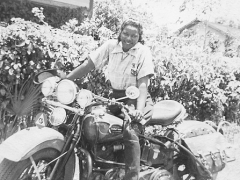
Date: Wednesday, April 11, 2012, 9:31 pm
By: Erica Taylor, The Tom Joyner Morning Show
Bessie B. Stringfield, a.k.a. “BB,” was the first black woman to make eight long-distance solo tours across the U.S. on a motorcycle. In the 1930’s, BB Stringfield rode her hot rod through areas known for racial violence and prejudice. She earned the nickname “The Negro Motorcycle Queen.” On her tours, Bessie Stringfield traveled through Brazil, Haiti and parts of Europe. Her next destination was determined by tossing a penny on a map. As she rode through Jim Crow country, BB would sometimes sleep on her motorcycle with a blanket if there were no safe places for her to stay during her trip.
Born in Kingston, Jamaica, BB Stringfield came to America as a child and was given up for adoption. At age 16, she was given a motorcycle by her Irish adoptive mother, who’s name she was not allowed to repeat. It was said that the woman gifted Bessie anything she wanted as long as he prayed to “the man upstairs” for it first. After she was gifted her first 1928 Indian Scout bike, BB Stringfield would later purchase another 27 motorcycles throughout her life.
Throughout her travels, BB performed motorcycle stunts for local carnivals. The press loved her balancing stunt while her Harley was in motion.
Bessie used her motorcycle talent to work as the only female civilian motorcycle dispatch rider in World War II. She quickly carried documents between military bases and sharpened her riding skills by riding over makeshift bridges. Once her tour was complete, she moved to Miami and founded the Iron Horse Motorcycle Club. In Miami, Stringfield secretly entered riding contests as a man, and after winning, removed her helmet to reveal her gender. As a result, she was often denied the prize money.
In her personal life, BB Stringlfied married and divorced six times. She lost three children over the years. Her final husband, Arthur Stringfield, asked that Bessie keep his last name because it made him famous.
Bessie Stringfield, the Negro Motorcycle Queen, died in 1993 at age 82 from an enlarged heart. Her memory was left with the remainder of her six-ex husbands. In 2002 she was inducted into the AMA Motorcycle Hall of Fame.
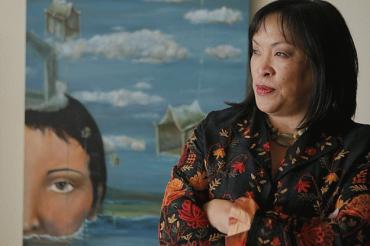
With her back toward the viewer and her right arm outstretched, a woman wearing a wheat-colored ballerina dress cups a billowy cloud edged with a crimson ribbon. Facing a desert landscape bordered with mountains, she gazes in the direction of three women, each connected to individual clouds via similar, scarlet-hued ribbons and positioned across the terrain.
This acrylic on canvas work, “Circus Series: The Cloud Walkers” (2011), is one of at least 10 in her Circus Series, including “Circus Series: Vivian and Her Synchronized Sea Plants” (2011) and “Circus Series: Cloud Walkers Rest Area” (2011), that reflects the magical realm in which surrealist painter and mixed-media artist Cynthia Tom’s imagination dwells.
She will exhibit 25 larger paintings, 30 smaller works and prints, re-envisioned secondhand shoes and more in her studio during the Mission Artists United “Spring Open Studios in the Mission” this weekend.
“It all starts with a quirky, slightly sick sense of humor that runs in my family,” says Tom of the beginnings of the Circus Series. “My dad is the impetus. One of the things that tied us together was watching ‘Monty Python’s Flying Circus’ as a family way back when.”
Born in San Francisco in the early 1960s, Tom still lives in the city. Her paintings depict powerful Chinese women in vibrantly hued, dreamy environs. Tom is also board president for the Asian American Women Artists Association. However, she didn’t grow up learning about her ancestry. Her father, Richard Tom, left Chinatown in the 1950s with his wife and child and moved to the Portola neighborhood.
“We were the only Asians out there at the time. My neighborhood was Greek, Italian, Anglo, Latin and African American,” she says. “I didn’t identify race. Everyone looked different because that was what people with different names and different families looked like, but not because of any myth their racial stereotype may have suggested. We were definitely all working-class kids and were always outside playing.”
Tom didn’t befriend any Asian American children until age 13, when she met Linda Leong and began working at a day camp at the Salvation Army in Chinatown.
“There are much more underlying reasons why my grandmother and parents didn’t teach too much about heritage; but the main one, I believe, is that they were all victims of trafficking one way or another. My father was sold (in China) to Chinese Americans and brought here at age 1,” she says. “My mother was traded by my grandfather for opium from 9 to 12 years of age. My maternal grandmother was sold as a second wife to my grandfather and treated more like a servant. When he died – leaving his family without any funds – his family, with funds, shunned my grandmother. She had to raise seven children on her own in Chinatown.”
Her artistic endeavors provoked Tom to research her family history. Maintaining a studio in Hunters Point Shipyard between 1990 and 2005, she initially based her paintings on found images from daily life and runway fashions, but her work lacked focus.
“JoeSam was a neighboring artist at Hunters Point Shipyard, an African American artist of great note. He became a mentor for my ethnic artistic path,” Tom says. “JoeSam told me that I would never be at my best if I didn’t explore my identity with my work; and he, of course, was right. It has led to the creation of art around my grandmother, mother and father, learning their history and in the process gaining a deep understanding of my motivations and emotional sludge, which I have since overcome.”
This spurred her designs of custom fabrics utilizing photographic images, including those of slave girls in Chinatown’s Bagnio District taken by Arnold Genthe in the early 1900s and of her infant father, then sewing them into pillows.
These evolved into “Discard & Variances,” a visual arts series about her family and the larger issue of human trafficking. The Yerba Buena Center for the Arts displayed the first installment in 2011. The second installment, “Discards & Variances: A Look at Human Trafficking,” is part of a group exhibition “Remnants: Artists Respond to the Chinese American Experience” at the Chinese Historical Society of America Museum.
“I understood Chinese New Year, but not much else. I’ve since learned some things, but I’m third generation,” she says. “Yet it is the exploration of my grandmother’s journey in the creation of my art that conjured forth my staunch feminism and advocacy for women and social justice.”
Cynthia Tom: “Spring Open Studios in the Mission.” Noon-6 p.m. Sat.-Sun. 1890 Bryant Street Studios, Suite 302, S.F. www.cynthiatom.com, www.1890Bryant.com, www.missionartistsunited.org. “Remnants: Artists Respond to the Chinese American Experience”: Opening Thurs. Chinese Historical Society of America Museum, 965 Clay St., S.F. www.chsa.org.
Stephanie Wright Hession is a freelance writer. datebookletters@sfchronicle.com
This article appeared on page F – 1 of the San Francisco Chronicle

By Jose de la Isla
Posted April 11, 2012 at 4:38 p.m.
MEXICO CITY — Elizabeth Catlett died April 2 at age 96 in Cuernavaca, 80 miles south of this capital city.
Most accounts of the U.S.-born artist simply referred to her as an African-American who became a Mexican citizen. A few typecast her as an “important African-American” artist to typify her work in sculpture and printmaking.
She was much more than that.
Mexico’s National Council for Culture and the Arts has described Catlett as an artist who always demonstrated in her art a profound interest “in social justice and the rights of black people and Mexican women.”
An obituary in the Los Angeles Times noted the U.S. government had labeled her an “undesirable alien” in 1959. It mentioned she was briefly held in a roundup of ex-patriots living in Mexico who were suspected of Communist activity. She was denied a U.S. visa throughout the 1960s.
The same obituary quoted her as once telling a St. Petersburg Times journalist that “there’s a different attitude toward art in Mexico. As an artist, you’re greatly admired rather than looked at as something strange.”
Catlett’s best-known prints include “Sharecropper” (1952) and “Malcolm X Speaks for Us” (1969), expressing her lifelong commitment to art as a tool for social change, often incorporating the slogan “Black is beautiful.” Her better-known lithographs include posters of Angela Davis.
Catlett had said she wanted to show the history and strength of women: urban, country, working and great women of history.
Her sculptures include “Dancing Figure” (1961), “The Black Woman Speaks” and “Target” (1970). “Black Unity” (1968) shows a mahogany fist on one side and two African visages on the other. The sculptures “Homage to Black Women Poets” and “Homage to My Young Black Sisters” (both 1968) are red-cedar abstracts of a woman with raised head and fist.
Her biography reveals how, in a sense, that one’s life and work fuse the same way nationality, ethnicity, identity, life mission and talents do.
Elizabeth Catlett was born in 1915 in Washington, D.C., the granddaughter of freed slaves, a math-professor father and truant-officer mother. In the 1930s, she earned her undergraduate degree from Howard University in Washington, D.C.
She was exposed to the work of Mexican muralists Diego Rivera and Miguel Covarrubias, both of whom had worked extensively in the United States.
Covarrubias, as an illustrator for The New Yorker and other national magazines in the 1920s and ’30s, had introduced to millions the image of sophisticated jazz-age Negroes and Harlem.
Catlett preferred doing semiabstract sculptures after studying the form as a graduate student at the University of Iowa, earning a master’s in fine art in 1940. She sculpted “Negro Mother and Child” for her graduate thesis and won first prize in the 1940 Columbia Exposition in Chicago.
That same year, she chaired the art department of New Orleans’ Dillard University. Later in the 1940s, she moved to Mexico City to study ceramics. She added struggles of Mexican workers to her commitment to African-American causes. She referred to “my two people,” even blending their physical features in her art.
She found like-minded spirits in the Taller de Grafica Popular, a collective known for mass-producing posters supporting populist causes. She met renowned artist Francisco Mora here and married him. He died in 2002.
In Mexico, Catlett gained an acceptance she had not known at home, the same as other U.S. artists, writers and musicians such as composer Aaron Copland have experienced. She continued championing black causes even after becoming a Mexican citizen in 1962.
Perhaps this has to do with artists having a responsibility, like that of writers, to show the quest for justice, catch individual temperament and mood, and expose their color and shape.
Jose de la Isla is a columnist for Hispanic Link News Service. Email him at joseisla3@yahoo.com.
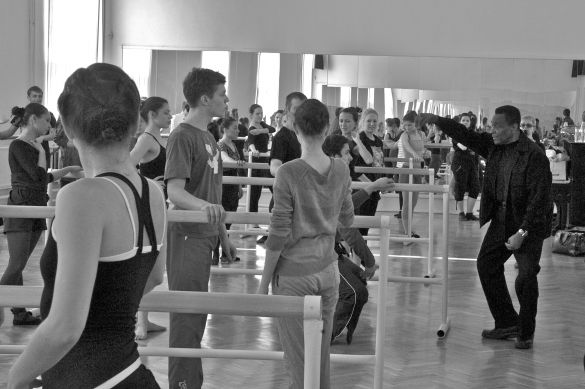
Mitchell, 78, first came to Moscow in 1962 as a dancer. His most recent visit saw him give a master class.
“The fallacy was that black people could not do classical ballet,” American ballet dancer Arthur Mitchell explained recently to an audience at the American Center Library. “So I said — ‘I’ll change it.'”
Arthur Mitchell became the first African-American to dance with George Balanchine’s New York City Ballet in November 1955, an unprecedented accomplishment in the race-divided America of that time. In 1962, Mitchell traveled with the company to Moscow, becoming, he says, the first ballet dancer of color to perform for Russian audiences.
In 1969, Mitchell co-founded the Dance Theatre of Harlem, which became one of the most prominent performing ensembles in the country. In 1988, the dance ensemble was invited to perform in Russia. Mitchell is currently visiting as a featured speaker for American Seasons, a cultural exchange set up by the U.S.-Russia Bilateral Presidential Commission.
Q: You visited Moscow with the New York City Ballet in 1962. What was your experience like as an American in Russia during the Cold War Era?
A: Things were so different back then. You couldn’t just go and walk out. We were on pins and needles because none of us had been to Russia before. The company had tremendous success. I had an extremely successful tour because they had never seen a black man dance ballet before.
Q: What were people’s reactions to your performance?
A: It was incredible. I would step on the stage and hear all around “That’s Arthur Mitchell. That’s Arthur Mitchell.” One of my great heroes was [Vakhtang] Chabukiani, the Georgian dancer. He was an older man at that time, but he came out of retirement and danced with me. Khrushchev was in power [at the time], and wherever I went, they would seat me in his box. The young lady I was with was from Denmark, so the people would say “Othello and Desdemona! Come Othello!” It was really kind of amazing.
Q: What was it like to return in 1988 with the Dance Theatre of Harlem?
A: People came to me with dance programs I had signed in 1962. Once the Russians accept you as an artist, they never forget you — particularly dancers. There was always a great love and respect. You’re revered here. The love of art here, particularly dance, is unparalleled. Dance is one of their favorite art forms. Everyone seems to know it and love it.
Q: How has Russian dance changed since the fall of the Soviet Union?
A: Even this trip now, we’re amazed at how much contemporary dance there is here. It’s very popular. Everyone wants to be a modern dancer. They have been doing classical ballet for centuries and want to try something new. We just went to a school, and they did a variation on Alvin Ailey’s “Revelations.” These little kids — it was really amazing. It’s still very new, but it’s something that I never thought would be very popular here, and it seems that everyone wants to do it.
Q: What sort of a relationship do you have with the Russian artistic community?
A: Great love and respect. So many of the Russian dancers are very good friends of mine, and all of my teachers were Russian. [George] Balanchine, [Anatole] Obukhov, [Pierre] Vladimiroff, Madame [Felia] Doubrovska. They are all great dancers of Russia who were living in America. They were teachers of mine. The more current generation — [Rudolf] Nureyev, [Mikhail] Baryshnikov, Nina Ananiashvili from Georgia, Natalia Makarova. The arts world is much different from the regular world. You always run into people.
There’s an interchange between Russia and America that I don’t think has ever happened before. Artistically, I’m not speaking politically now. The exchange of cultures is very, very popular. The Bolshoi has hired their first American principal dancer. That’s unheard of. And the Kirov has just hired a young American girl. That’s something you would never think of, hiring an American to be one of their leading dancers, because their tradition, their syllabus, their training is so specific.
Q: Given the chance, would you come back a fourth time?
A: That’s what we hope will happen. This initiative is a collaboration between the President of America and the President of Russia. They wanted this cultural exchange. What is interesting is it’s based on what Diaghilev did when he took Russian music and dance to Paris so that the world would see what Russian art was like. This is the initiative that is happening through the American Embassy here: American Seasons. As an artist you get a chance to travel the world and see things that you normally wouldn’t. You get a feeling for people much better than a businessman or a politician could get.

The first film is a small, self-distributed drama about fatherhood and family, a passion project from first-time filmmaker Noel Calloway with a cast of newcomers. The second movie, a kidnapping drama starring Blair Underwood, was produced and is being released by Codeblack Entertainment, the company behind last year’s Kevin Hart concert movie, “Laugh at My Pain,” which grossed more than $7.7 million in domestic release.
Yet the two productions both hope to draw moviegoers that their filmmakers feel are hungry for content and can be reached without expensive national television advertising.
“It is a very, very underserved audience,” Jeff Clanagan, the president and chief executive of Codeblack, said of African American patrons, whom he estimated would make up more than 90% of the film’s audience.
Calloway’s path to the screen was not easy.
He wrote the “Life, Love, Soul” script in 1997, soon after graduating from high school in Harlem. “At my graduation, I looked out at the audience and saw mostly mothers and grandmothers,” Calloway said. He struggled raising money to finance his tale of a young man raised by a single mother who has to move in with his estranged father, and his lead investor pulled out halfway through filming in 2007. Calloway, who himself was raised by a single mother, wasn’t able to resume production for two years and only now has brought the movie to theaters; the film is opening in a handful of markets across the country.
“Woman Thou Art Loosed” is a sequel of sorts to the 2004 movie of the same name, based on the novel by Dallas minister T.D. Jakes, who serves as an executive producer on the new film. The movie will premiere in about 100 screens in more than a dozen cities nationally.
While Clanagan said the film could struggle generating big returns in some markets, he was optimistic “Woman Thou Art Loosed” will do well in Atlanta, Baltimore and Washington. “Our target audience is not going to see ‘The Three Stooges,’” he said of 20th Century Fox’s wide-release comedy.
Like “Life, Love, Soul,” Clanagan is using very targeted marketing to reach African American ticket buyers, relying heavily on word-of-mouth screenings and social media. “We’re not buying a lot of network television shows, but we did buy ads on VH1’s ‘Basketball Wives,’” Clanagan said of the cable television reality series.
Calloway hopes his film can find a broader audience. “It isn’t a black story,” the filmmaker said. “It’s about people, it’s about family, it’s about overcoming challenges.”
This article first appeared at LA Times.